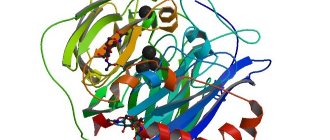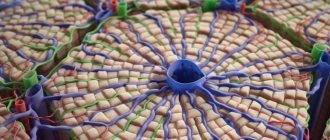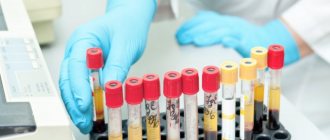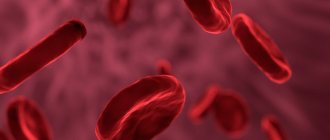Indications for analysis
An increase in amylase concentration is often asymptomatic, but sometimes the following signs are indications for testing:
- pain in the abdominal region or in the right hypochondrium, which becomes intense after eating;
- defecation disorders - mainly diarrhea, but sometimes disorders are accompanied by constipation;
- deterioration in general health - weakness, lethargy, deterioration in performance;
- the presence of altered areas of the pancreas that were identified by palpation, ultrasound or other studies.
The level of amylase in the blood is detected using a biochemical blood test, or less often urine. This is one of many research indicators - according to its indicators, along with lipase and other enzymes, the doctor can judge the state of the patient’s gastrointestinal tract.
Reasons for the increase
An increase in pancreatic amylase means that the glands are affected: the pancreas or the salivary glands. Less often we talk about functional disorders such as diabetes, cirrhosis, and gastrointestinal diseases.
There are several dozen factors in the development of the pathological process. It is worth considering the main disorders that can provoke the disorder.
Mumps
Occurs relatively often. This is mainly a pediatric disease. Pathological process that affects children. Patients aged from 3 to 15 years suffer. Adult forms are rare, but this is the exception to the rule.
The essence of the disorder is damage to the glands of the body: in particular, the testicles, pancreas and salivary structures are affected - hence the natural increase in amylase, relatively speaking. The substance is synthesized in large quantities, which is why the analysis gives positive results.
The pathological process is accompanied by a group of specific symptoms:
- Puffiness of the neck. This is the result of inflammation of the salivary glands. The patient looks unnatural.
- Painful sensations. When swallowing and palpating the affected area.
- Digestive disorders.
- Discomfort in the left side of the abdomen.
- Nausea.
- Vomit.
- Stool disorders.
- Increased body temperature. Which is quite understandable. After all, mumps is an infectious, viral process. Indicators reach levels of 38-39 degrees. Sometimes less. Sometimes it’s more.
This is only part of the manifestations. As for treatment, it is handled by a pediatrician.
Attention:
There is no etiotropic correction. That is, you need to fight the symptoms and prevent unwanted consequences.
Among the methods of total elimination of violations:
- A bland diet for a week or more.
- Bed rest for 7-12 days.
- Prednisolone and glucocorticoids to avoid testicular atrophy and orchitis itself (inflammatory process of the seminal structures).
- Vitamin-based preparations. Mineral complexes to support the patient's body.
Inpatient treatment is practically not required. Because the disorder generally occurs easily. The mortality rate is barely 1 person in 100,000.
Severe types of the pathological process are still corrected in the hospital. Everything takes up to several weeks. At the same time, the patient is under the supervision of doctors.
There is no need to adjust amylase in a special way. It will return to normal on its own as soon as the disturbance goes away.
Diabetes
Chronic pancreatic disease, to put it simply. In reality, it is a complex condition in which insulin production is impaired.
On the other hand, the synthesis of the substance may be normal. But tissues are not sensitive enough to this compound. Accordingly, the effect will be exactly the same.
As for the high concentration of amylase in the analysis, this is the result of compensation of the body. Simply put, the body is trying to normalize its own condition and increases the load on the pancreas. The concentration of the enzyme increases.
However, this does not matter. The dysfunction is too serious, such correction measures and self-regulation are not enough.
Diabetes mellitus is accompanied by several manifestations.
Among them:
- Increased pressure. As a result of the formation of special cholesterol plaques on the walls of the arteries.
- Vascular dysfunction. Blood thickening. What causes the pathological process. For example, thrombosis, phlebitis and others.
- Decreased brain activity. As a result of the course of ischemic conditions. This is the result of blockage of blood vessels by large cholesterol plaques.
- Atherosclerosis. Not really a symptom, more of a typical syndrome or complication. A characteristic feature is the deposition of fat on the inner lining of the arteries.
And so on. Treatment is the task of the endocrinologist. In order to correct the condition, it is necessary to restore carbohydrate metabolism. This is done by changing the diet.
A gentle diet low in fat and energetically valuable compounds is recommended. Insulin is used occasionally as needed. As the main means of emergency action. To reduce sugar levels.
Restoring amylase to normal values presents certain difficulties, since the body has already been changed and switched to pathological “rails,” but this must be achieved. Or at least keep the indicator at approximately the same level.
Inflammation of the pancreas
The so-called pancreatitis. Accompanied by pathological changes in the body. They develop rapidly and can lead to human death.
The acute form is extremely dangerous in terms of mortality. Because tissue necrosis begins very quickly. Their dying off. In the end, you cannot do without surgery.
The pathological process is characterized by a group of dangerous and uncomfortable symptoms:
- Intense pain in the left side of the abdomen. They develop spontaneously. As a result of damage to local structures. The severity of the pain is such that patients can go into shock. As for localization, they are encircling. They start in the left side, go to the lower back and beyond.
- Nausea.
- Vomit.
- Weakness and drowsiness.
- Significant increase in body temperature. Develops suddenly. Growth persists for several hours. After which the level freezes in one place.
- Feeling overwhelmed.
- Possible disturbances of consciousness. Syncope.
Treatment is carried out under the supervision of a specialist in endocrinology and surgery at the same time. It is possible to attract doctors of different specialties (rather than several profiles in one person).
Urgent therapy, in a hospital setting. Surgical correction is prescribed. The affected area of the pancreas is excised so that the remaining tissue remains functionally active. After resection, hormonal drugs and enzymes are indicated for some time.
Chronic forms of the pathological process sometimes do not require hospital treatment. Enough medications. Which ones exactly are decided by specialists. The issue is left to their discretion.
Renal dysfunction
Relatively rare. According to various estimates, from 1 case per 1,000,000 population of the planet. Moreover, it is much more often diagnosed in patients who already have a history of problems with the paired organ.
The disorder is accompanied by a group of dangerous manifestations. First, it is worth saying that amylase increases as a result of insufficient excretion of the substance in the urine, since this is the way the structure leaves the human body. The concentration increases gradually. The more intense the pathological process, the more significant the reabsorption.
As for the signs of kidney failure, the following points can be mentioned:
- Pain in the lower back. Sudden. Not like colic, less intense. But painful, long.
- Urinary disorders. Rare urge to visit the toilet. At the same time, the amount of urine objectively decreases daily. Up to 500 ml. This condition is called oliguria.
- Increased blood pressure. At an advanced stage of the pathological process. The indicator is stable, that is, it never decreases on its own. This is the so-called malignant hypertension. It hits the brain, blood vessels, and eyes. If nothing is done, the patient is likely to die from complications.
Amylase returns to normal as soon as the filtering function of the kidneys is restored. This can be problematic. Especially if the process is running and old.
Diuretics are prescribed (at the initial stage), although not always. Hemodialysis is also indicated. Hardware blood purification. Thanks to this, it is possible to adjust the amylase concentration.
As for the total technique, kidney transplantation is indicated. Unfortunately, due to a lack of donors, many remain without treatment.
Stomach diseases
If amylase is elevated, the likely cause is a malfunction of the digestive tract, in particular the stomach may be the culprit. Pathologies of this mass structure. From gastritis to ulcers.
Violation of amylase concentration occurs due to its active absorption into the blood.
As for manifestations, they depend on the specific diagnosis. Most often the following symptoms occur:
- Pain in the epigastric region. That is, just above the navel.
- Discomfort in the abdomen. Heaviness, seething.
- Increased production of intestinal gas.
- Digestive disorders.
- Vomit.
- Nausea.
- Belching.
- Heartburn. With a sour taste in the mouth.
- Diarrhea.
- Constipation.
All the “delights” of dyspepsia are evident. At the same time, the severity of the condition depends on the duration of the disease.
Recovery is carried out under the supervision of a gastroenterologist. Several types of drugs are prescribed. Antacids to reduce the production of gastric juice and its acidity.
Also proton pump inhibitors. For total correction. It is possible to use sorbents and other medications depending on the situation.
Amylase returns to normal on its own. After the pathological primary condition has been corrected.
Cirrhosis of the liver
Acute or chronic disease. With it, tissue death of the largest gland in the body is observed. The load on all systems increases. In particular, the enzymatic structure also suffers.
At the initial stage, this leads to an increase in indicators. Then, to a decrease in amylase. How quickly depends on the rate of progression of the pathological process.
As for the manifestations of the disorder, they are clearly visible:
- Severe or moderate pain in the right side. Under the ribs.
- A feeling of fullness in the same localization.
- Increased bleeding. Reduced rate of coagulation of liquid tissue. Well noticeable in case of injuries and wounds.
- Nausea.
- Vomit.
- The formation of spider veins on the body. In the area of legs, arms, abdomen. "Spiders" look red or purple. These are plexuses of capillaries.
Treatment is carried out under the close supervision of a hepatologist. Sometimes a gastroenterologist is involved if there is no specialist.
Drugs of the protector group are prescribed. To protect the liver from harmful influences from the outside and inside. Enzymes are used to correct digestion.
The process is not fast. The patient may have to take the pills for the rest of his life or most of it.
As for surgical measures, only a liver transplant will help. Again, there is a problem with donors. Therefore, help becomes unlikely.
Sialadenitis
{banner_banstat9}
Impaired functional activity of the salivary glands during inflammation. Most often it is of infectious origin. But there are also idiopathic forms, when it is difficult or impossible to determine the genesis of the pathological condition.
Amylase increases as a result of a natural increase in the activity of the salivary glands (hyperstimulation occurs).
Typical symptoms:
- Pain in the mouth, behind the ears, under the lower jaw.
- Increased saliva production. Hypersalivation.
- Increase in body temperature. Up to 37 to 39 degrees Celsius. Depends on the severity of the pathological process and the degree of immune activity.
Treatment and diagnosis are carried out under the supervision of infectious disease specialists. Also ENT doctors. Variants are possible.
Antibiotics and anti-inflammatory drugs are prescribed. Antiviral drugs, interferon-based medications. Also antipyretic.
Lots of ways and techniques. The question of what means to use is decided by the doctor. On the spot.
An amylase test is carried out in cases where the development of one of the pathological processes is likely. Restoration is appropriate. Depends on the specific disorder.
Normal values
Total amylase by age
- 0-30 days (newborn): 0-6 units/l;
- 31-182 days: 1-17 units/l;
- 183-365 days: 6-44 units/l;
- 1-3 years: 8-79 units/l;
- 4-17 years: 21-110 units/l;
- after 18 years (adults): 26-102 units/l.
Pancreatic amylase by age
- 0-24 months: 0-20 units/l;
- 2-18 years: 9-35 units/l;
- after 18 years: 11-54 units/l.
(Please note that reference intervals may vary between laboratories, so for blood and urine tests please refer to the intervals listed on the report).
Interference:
- Substances that cause reduction of the sphincter of Oddi (for example, betanehol, diphenoxylate, narcotic analgesics), secretin, ethanol, asparaginase, azathioprine, captopril, cimetidine, clofibrat, corticosteroids, ciproprogeptadin, didanosine, estrogen, eastrocrinic acid, fusemide, ibuprofen, and ibuprofen, and ibuprofen, and ibuprofen, and ibuprofen, and ibuprofen, and ibuprofen Enamic acid , methyldopa, nitrofurantoin, oral contraceptives, pentamine. Phenylbutazone, sulfonamides, sulindac, tetracycline, valproic acid.
- Anabolic steroid.
Blood amylase level
Since the pancreas is a mixed secretion gland (it secretes hormones and enzymes both into the intestinal lumen and into the blood), the amylase produced in it is usually distinguished from general alpha-amylase and called pancreatic amylase. Accordingly, in a biochemical blood test (or urine, which is also used to determine the level of amylase in the body), two indicators of amylase are distinguished: alpha-amylase and pancreatic amylase.
Alpha amylase
For alpha-amylase (representing the total amount of all amylase in the body), the following values are considered normal: *
- children under 2 years old: 5 - 65 U/l;
- 2 years – 70 years: 25 – 125 U/l;
- over 70 years old: 20 - 160 U/l.
*according to independent laboratory Invitro
Pancreatic amylase
Alpha-amylase includes pancreatic amylase, the amount of which is also measured. The normal amount of pancreatic amylase is considered*:
- children under 6 months: <8 U/ml; children 6 - 12 months: <23>
- all over 1 year: <50 U/ml.
*according to independent laboratory Invitro
- Amylase. Normal blood levels in women, men, children by age, table. What does it mean increased, decreased, treatment
Reasons for deviations from the norm
Reasons that cause an increase in the amount of alpha-amylase in the blood (increased blood amylase is considered to be figures above 105 units/l for alpha-amylase and above 50 units/l for pancreatic amylase):
- Acute or chronic pancreatitis. With inflammation of the pancreas, the secretion of amylase by cells increases several times
- A cyst, tumor or stone in the lumen of the pancreas. A change in the structure of the gland causes compression of the glandular tissue and its secondary inflammation, which increases the secretion of amylase (amylase level reaches 150-200 units/l).
- Parotitis. Inflammation of the salivary glands also causes increased secretion of amylase (.
- Peritonitis. With peritonitis, all organs of the abdominal cavity, including the pancreas, are subject to irritation and inflammatory changes. Such changes increase the activity of pancreatic cells, which leads to increased amylase levels in the blood test.
- Diabetes. Diabetes mellitus causes systemic metabolic disorders, including carbohydrate metabolism. Thus, not all amylase produced by the body will be rationally spent on converting starch into oligosaccharides, which will lead to an increase in its amount in the blood.
- Kidney failure. Since amylase is excreted from the body through the kidneys, insufficient kidney function will cause a delay and increase in the amount of enzyme in the blood.
Reasons for a decrease in the amount of amylase in the blood (a decrease in the level of blood amylase is considered to be less than 100 units/l for alpha-amylase):
- Hepatitis in acute or chronic form. With hepatitis, carbohydrate metabolism is disrupted, which entails an increased load on the body's enzymatic systems, including amylase. For a certain time, the pancreas produces a sufficient amount of the enzyme, but subsequently begins to slow down the process of amylase synthesis, which will be reflected in its low amount in a blood test.
- Pancreatic tumors. Some tumors cause degeneration of pancreatic tissue, which makes amylase secretion impossible.
Also, as a result of injuries, falls from a height and poisoning, amylase secretion may be impaired, either to a greater or lesser extent.
When is an α-amylase test prescribed?
- For any unclear abdominal pain, this test is prescribed, primarily to diagnose acute pancreatitis (in 75% of cases of this disease, multiple elevated levels of the enzyme are detected in both the blood and urine).
- For the diagnosis of chronic pancreatitis, the study of this enzyme is less important: in this case, alpha amylase is increased much less frequently. In more than half of the patients, its level remains normal, but if you examine fractions, then the excess of P-type amylase activity over S-type will be of great benefit for the diagnosis of chronic pancreatitis.
- To clarify the diagnosis of mumps - inflammation of the salivary glands. In this case, the S-fraction of the enzyme will be increased in the blood.
- To monitor treatment for pancreatic cancer.
- After operations in the pancreaticoduodenal zone.










